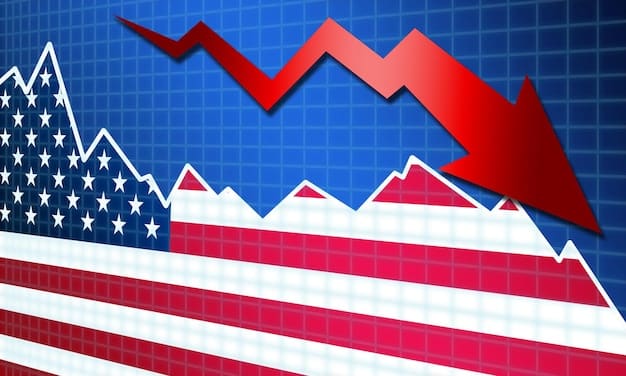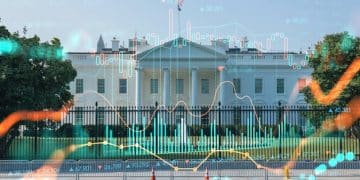Inflation’s Impact: How 3.5% Affects Your US Dollar in 2024

With the current inflation rate at 3.5% in 2024, the purchasing power of the US dollar is reduced, meaning consumers can buy fewer goods and services with the same amount of money due to increased prices.
Understanding how does the current inflation rate of 3.5% affect the purchasing power of the US dollar in 2024 is crucial for making informed financial decisions. Let’s delve into the specifics to unravel how rising prices influence your money’s worth.
Understanding the Current Inflation Rate
The current inflation rate serves as a vital indicator of economic health, reflecting the pace at which the general price level of goods and services is rising. This rate is typically expressed as a percentage, offering a straightforward way to gauge the change in prices over a specific period, usually a year.

Several factors contribute to inflation, including demand-pull inflation, which happens when demand for goods and services outstrips supply, and cost-push inflation, which arises when the costs of production, such as wages and raw materials, increase. Understanding these drivers is key to comprehending the broader economic landscape.
Key Economic Indicators Affected by Inflation
Inflation significantly influences several key economic indicators, creating a ripple effect throughout the economy.
- Interest Rates: Central banks often adjust interest rates to manage inflation. Hiking rates can curb spending and investment, helping to cool down an overheating economy.
- Unemployment: Inflation and unemployment often have an inverse relationship. Policymakers must strike a balance between controlling inflation and maintaining a healthy employment rate.
- GDP Growth: High inflation can hamper economic growth by eroding consumer spending and business investment. Stable and moderate inflation is generally considered conducive to healthy GDP growth.
In conclusion, the current inflation rate is a critical metric that reflects the overall health of the economy and influences various financial decisions. Understanding the factors that drive inflation and its impact on key economic indicators is essential for consumers, investors, and policymakers alike.
The Purchasing Power of the US Dollar Explained
The purchasing power of the US dollar is a fundamental concept in economics, representing the quantity of goods and services that one dollar can buy at a given time. When inflation rises, the purchasing power of the dollar declines, meaning you can buy less with the same amount of money.
Economists often use the Consumer Price Index (CPI) to measure changes in purchasing power. The CPI tracks the average change in prices paid by urban consumers for a basket of goods and services, providing a benchmark for assessing the impact of inflation on the dollar’s value.
Let’s compare the current purchasing power of the US dollar to previous years to see how inflation has eroded its value.
- Historical Data: Over the past few decades, the US dollar has experienced significant fluctuations in purchasing power due to varying inflation rates.
- Impact of Specific Events: Economic recessions, oil price shocks, and global pandemics have all contributed to changes in the dollar’s purchasing power.
- Long-Term Trends: While the dollar’s purchasing power has generally declined over the long term, periods of low inflation have allowed it to stabilize or even increase temporarily.
In conclusion, the purchasing power of the US dollar is a dynamic measure that reflects the impact of inflation on the value of money. Understanding how inflation erodes purchasing power is essential for making informed financial decisions, from budgeting and saving to investing.
How a 3.5% Inflation Rate Affects Everyday Expenses
A 3.5% inflation rate has a direct and noticeable impact on everyday expenses, affecting the cost of groceries, transportation, housing, and healthcare. Consumers often feel the pinch as prices rise, reducing their ability to maintain their current standard of living.
The cost of essential goods and services increases when the inflation rate rises. For example, if the price of a gallon of milk increases by 3.5%, consumers have to spend more to purchase the same quantity.
Let’s examine specific examples to illustrate the impact of a 3.5% rise in the cost of living.
Impact on Groceries

With a 3.5% inflation rate, the cost of everyday grocery items is likely to increase. The total monthly spend on groceries is higher making it difficult for low income households.
Impact on Transportation
Transportation expenses, including gasoline, car insurance, and maintenance, are also affected by inflation. As the price of gas goes up, so does the overall cost of commuting and traveling.
Impact on Housing
Housing costs, including rent and mortgage payments, tend to rise with inflation. Landlords may increase rent to keep up with their own expenses, while rising interest rates can make mortgages more expensive.
In conclusion, a 3.5% inflation rate affects everyday expenses. Consumers must adjust their spending habits to adapt to the rising cost of living.
Strategies to Protect Your Purchasing Power
Protecting your purchasing power during periods of inflation requires implementing several strategies to mitigate the negative effects of rising prices. These strategies include investing in assets that tend to outpace inflation, adjusting spending habits, and seeking additional sources of income.
Investing in assets like real estate, stocks, and commodities can help preserve and grow your wealth during inflationary periods. These assets often increase in value as prices rise, providing a hedge against inflation.
Let’s explore specific investment options that can help protect your purchasing power.
- Real Estate: Real estate tends to appreciate in value during inflationary periods, making it a good investment option. Rental income can also increase with inflation, providing a steady stream of cash flow.
- Stocks: Investing in stocks, especially those of companies that can pass on rising costs to consumers, can help you stay ahead of inflation. Look for companies in sectors that are less sensitive to economic downturns.
- Commodities: Commodities like gold, silver, and oil often serve as a hedge against inflation. Their prices tend to rise as inflation increases, preserving your purchasing power.
In conclusion, protecting your purchasing power during periods of inflation requires implementing proactive strategies. By investing in assets that tend to outpace inflation, adjusting spending habits, and seeking additional sources of income, you can safeguard your wealth.
The Federal Reserve’s Role in Managing Inflation
The Federal Reserve (commonly known as the Fed) plays a crucial role in managing inflation through monetary policy. Its main tool is adjusting the federal funds rate, which influences interest rates throughout the economy. When inflation rises, the Fed may increase interest rates to curb spending and cool down the economy.
The Federal Reserve uses a variety of tools and strategies to maintain price stability and promote maximum employment. Monitoring economic indicators, communicating policy decisions, and coordinating with other government agencies are all part of the Fed’s approach.
Here are some specific monetary policy tools the Fed uses to manage inflation.
Adjusting the Federal Funds Rate
The federal funds rate is the target rate that the Fed wants banks to charge one another for the overnight lending of reserves. By raising or lowering this rate, the Fed influences borrowing costs throughout the economy.
Open Market Operations
Open market operations involve the buying and selling of government securities to influence the money supply and interest rates. Buying securities injects money into the economy, while selling securities withdraws money.
Reserve Requirements
Reserve requirements are the fraction of a bank’s deposits that they are required to keep in their account at the Fed or as vault cash. Adjusting reserve requirements can impact the amount of money that banks have available to lend.
In conclusion, the Federal Reserve manages inflation through monetary policy, using tools. Through communication, data analysis, intervention and planning, and constant market adjustments, the Federal reserve greatly affect inflations trends across the national.
Long-Term Economic Outlook with a 3.5% Inflation Rate
Projecting the long-term economic outlook with a sustained 3.5% inflation rate requires considering various factors, including economic growth, employment, and government policies. While a moderate level of inflation can stimulate economic activity, a sustained rate of 3.5% could lead to negative consequences over time.
Economists use various models and forecasts to assess the potential impact of different inflation scenarios on the economy. These models take into account factors such as consumer spending, business investment, and international trade.
Let’s discuss some potential long-term economic consequences of a sustained 3.5% inflation rate.
- Erosion of Purchasing Power: Over time, a 3.5% inflation rate will continue to erode purchasing power, making it more difficult for consumers to afford goods and services.
- Impact on Savings and Investments: Inflation can reduce the real return on savings and investments, especially if interest rates remain low.
- Effect on Retirement Planning: Retirees and those planning for retirement may need to adjust their strategies to account for the impact of inflation on their savings.
In conclusion, projecting the long-term economic outlook with a sustained 3.5% inflation rate requires careful analysis of economic indicators and potential consequences. Policymakers, businesses, and individuals need to adapt to the changing economic environment to mitigate the negative effects of inflation.
Personal Finance Strategies for Inflationary Times
Navigating personal finances during inflationary times requires adopting proactive strategies to manage expenses, protect savings, and grow wealth. Creating a budget, reducing debt, and seeking additional sources of income are essential steps to take.
Creating a budget helps you track your income and expenses, allowing you to identify areas where you can cut back on spending. Prioritize needs over wants, and look for ways to reduce unnecessary expenses.
Let’s explore some specific personal finance strategies to consider in an inflationary environment.
Creating a Detailed Budget
Start by listing all your sources of income and tracking your monthly expenses. Use budgeting apps or spreadsheets to monitor your spending habits and identify areas where you can make adjustments.
Reducing Debt
High-interest debt can become even more burdensome during inflationary times. Focus on paying off high-interest credit card debt and loans to free up cash flow and reduce your overall financial burden.
Seeking Additional Income
Consider pursuing additional sources of income to supplement your earnings. This could include taking on a part-time job, freelancing, or starting a side business.
In conclusion, navigating personal finances during inflationary times requires a proactive and strategic approach. By creating a budget, reducing debt, and seeking additional sources of income, you can safeguard your financial well-being and adapt to the changing economic environment.
| Key Point | Brief Description |
|---|---|
| 💸 Purchasing Power | Inflation reduces what you can buy with the same amount of money. |
| 📈 Investment Strategies | Consider investing in assets like real estate, stocks, and commodities. |
| 💰 Budgeting | Create a budget to track and manage your expenses effectively. |
| 🏦 Federal Reserve | The Fed manages inflation through setting monetary policy. |
FAQ
▼
Inflation is the rate at which the general level of prices for goods and services is rising, and subsequently, purchasing power is falling. It’s typically expressed as a percentage.
▼
Inflation reduces the purchasing power of the US dollar, meaning you can buy fewer goods and services with the same amount of money as prices increase.
▼
Consider investing in assets like real estate, stocks, and commodities, create a detailed budget, reduce debt, and seek additional sources of income to protect your wealth.
▼
The Federal Reserve manages inflation through monetary policy, primarily by adjusting the federal funds rate, conducting open market operations, and setting reserve requirements for banks.
▼
High inflation can lead to the erosion of purchasing power, reduced returns on savings and investments, and challenges for retirement planning, impacting overall economic stability.
Conclusion
Understanding the dynamics of inflation, particularly how a 3.5% rate affects the purchasing power of the US dollar in 2024, is vital. By implementing proactive strategies, consumers and investors can navigate these financial waters and mitigate the impact on their personal finances.





